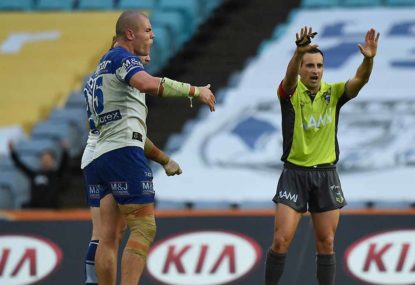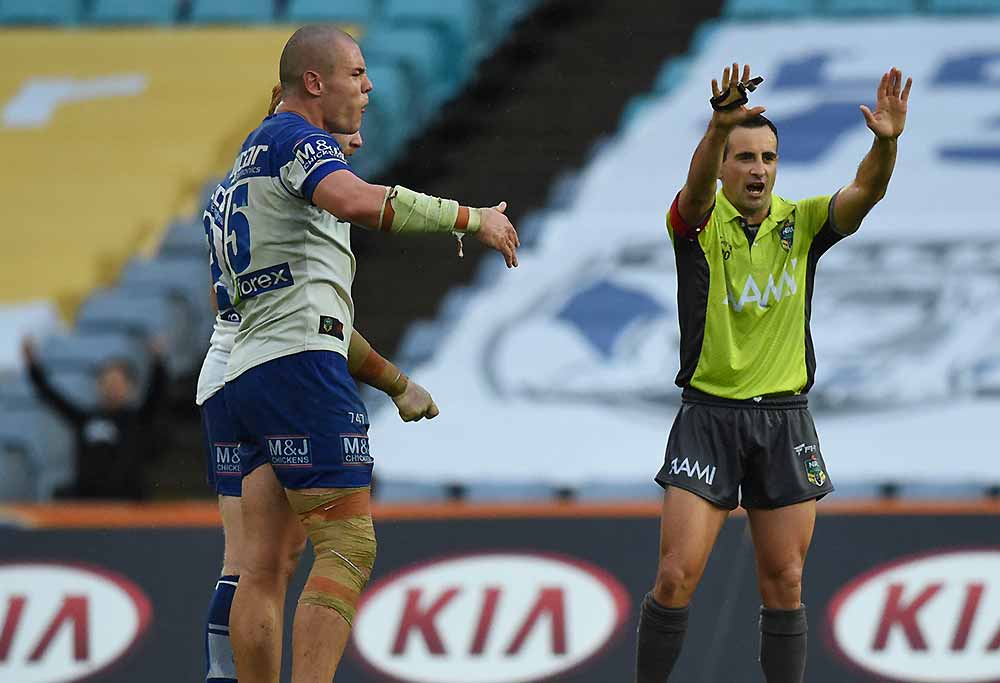Five and a kick: Benji's Tigers lost to Penrith, but did they actually win in the long run?
1. Tigers earning their stripes The Tigers played Souths last year when the Bunnies were at their very highest point. Tim Sheens coached them…

There has been much debate this week as to why Iosia Soliola was not sent-off for his high, late tackle on Billy Slater. I know why.
Firstly, let’s look at the history of send-offs in recent years.
Since Round 12, 2008, where two players were sent off in that round alone, there have only been five send-offs. That is five – count them – in 242 rounds of regular season NRL, up to the end of Round 20, 2017.
Or to put it another way, in 1,786 games since Round 12 2008, five players have been sent off. That equates to roughly one every 357 games. There have been no send-offs in finals matches since the NRL formed.
So, what were the send offs? How bad do the players have to be to be sent off? The tale is quite interesting.
After 36 rounds where no player had been sent off, Luke Douglas was the first. Sent off in the 27th minute of his Round 25, 2009, clash for a high tackle. The fallout from this? Referee Phil Haines was sacked by the NRL. And Douglas took an early guilty plea and didn’t sit out a single game.
The Sharks, who Douglas was playing for, lost that game 18-16. So, you could, and would, argue it cost them the game and cost Haines his job, although he did still referee up to the end of 2014.
The next send-off came more than a season later. In Round 1 of 2011, Cronulla’s Paul Aiton was sent off for a headbutt in the 75th minute. It was Blake Ferguson’s first game for Canberra, having left the Sharks at the conclusion of the 2010 season. He had spruiked that he wanted to go to a club that could win a premiership.
It was a heated encounter, but the game finished 40-12 to the Raiders and the send-off came so late that it had no effect on the outcome. Aiton received a one match suspension.
The next send-off was in Round 9, 2013 – again, a whole season in between with no send-offs.
This send-off was very similar to the Soliola hit on the weekend, as Jared Waerea-Hargraves braced, with a swinging arm to a rampaging George Rose. The difference being it wasn’t late, but Rose did stumble and drop prior to contact.
Again though, the game was already over, with the Roosters winning 16-4 and this send-off occurring in the 69th minute. However, the NRL judiciary clearly deemed it as bad, giving Warea-Hargraves five games on the sideline.
[latest_videos_strip category=”rugby-league” name=”Rugby-League”]
Skip forward to Round 24, 2013, surprisingly only 15 rounds later, and Kade Snowden is sent-off in the 65th minute of Newcastle’s clash with the Cowboys when they were trailing 24-6. The tackle broke Ray Thompson’s jaw and cost Snowden seven weeks on the sideline. Again, though, it didn’t affect the outcome of the game.
And the last send-off in the 1,786 games since Luke O’Donnell and Adam Cuthbertson were sent off in the same week? David Shillington’s 79th-minute headbutt on Aaron Woods. Yet again, no effect on the result. Shillington had lost the ball to give the Tigers the chance to run out the clock. The game was over.
Now the interesting part of the tale. Shillington, with that 79th-minute send-off, took an early guilty plea and served no suspension. However, in the same game, Joey Leilua was put on report for a shoulder charge and was suspended for two weeks.
Now, how does that make sense? What are the referees doing? Leilua gets to stay on the field, yet gets suspended, while Shillington gets sent-off, albeit with less than a minute to play, and gets no suspension.
For me, the turning point was way back in 2009.
Phil Haines controversially sends a player off and gets dropped from the NRL.
What message does that send to the referees? Send a player off; risk your job.
Ever since that game, there has not been one send off when a game is in the balance. The earliest send off in the years since 2009 is the 65th minute. That game was already lost, with the Knights trailing by 18 points, and the ensuing penalty giving the Cowboys a 20 point lead.

So, what’s the solution?
Well, we must take the pressure off the referees. Surely every fan can accept that the referees in the NRL are under immense pressure, and it’s not helped by a referee’s boss who constantly throws them under the bus.
How do we take the pressure off though?
We have the Head Injury Assessment (HIA) in play now.
Player safety is paramount in light of the court cases in the NFL, and it’s a good thing.
So, we have to introduce a simpler system. Don’t get rid of the send-off completely, but give referees another door out to dispatch a player.
The way to do that is to combine the HIA and the send-off into a joint ‘project’.
If any player has to be taken from the field – for an HIA, or an injury – and the reason is an opposition player committed a reportable offence against that player, then the fouling player has to leave the field for the same period of time.
Though he can be replaced, it does cost the offending team an interchange, while the fouled team gets a free interchange and they get to bring in an 18th player if the fouled player cannot return to the field.
Let’s make it for all injuries – not just head injuries. Slater would have classified as an HIA on the weekend, but, it is irrelevant. If there is a reportable offence, and the player fouled must leave the field, so must the offending player.
It takes the pressure off the referees and because it does not reduce the game to 13 on 12, it will have less of an effect on the result of the match.
Now, I know there are people out there who will say, “Won’t that just encourage a team to send out a second-string player to take out one of the oppositions best players to gain an advantage?”

(AAP Image/Mick Tsikas)
There are two arguments to that. Firstly, why aren’t teams doing that now anyway?
Under this system, you are more likely to lose a player, because any reportable offence where a player gets injured, you lose the offending player for the rest of the game. However, as it currently sits, you could employ that tactic now and not lose a player, because refs aren’t sending anyone off.
Secondly, the offending player will likely spend a few weeks on the sideline if the play looks intentional. How many players can a team go through and still be in the running to win the competition?
History has shown that teams that use more players in a season tend to finish at the lower end of the table. The team that avoids injuries and suspensions tends to win the competition. So, there isn’t much motivation to use more and more players to try to gain an advantage for one week.
Also, how can any NRL team afford to sacrifice one of their best 17 for a single win? I don’t think it would be a very effective tactic.
The other side effect people might think could happen is second-string players feigning injury to get a better player from the other team off the field.
But, remember, the player who offends needs to have done something worthy of going on report.
If the incident is incidental, there is a strong chance a player could go off the field for an HIA only to find that the player who ‘fouled’ him stays on because the referees didn’t see anything wrong with it.
Is that a risk worth taking? Should we also introduce a rule for players diving? Probably worth a look too.
In the last two weeks, Canberra have rolled the dice. Papalii hitting Dugan in the 57th minute but staying on the field to help complete a comeback win. Soliola hitting Slater in the 50th minute but losing the game anyway.
Had my rule been in place, perhaps Canberra would have lost both games.
Tell me what you think Roarers!